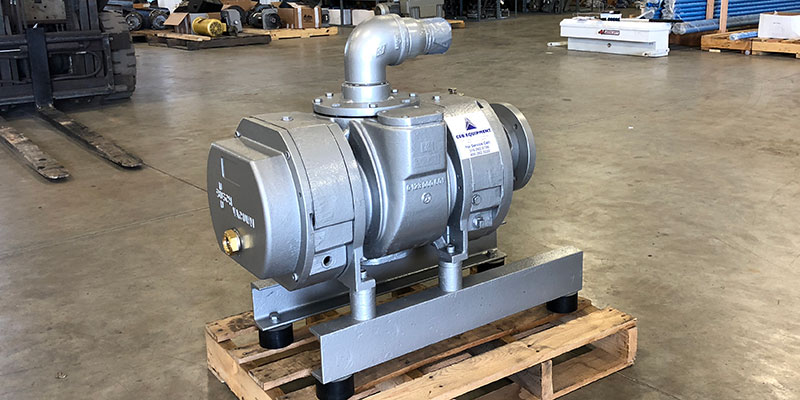
5 Signs It’s Time to Replace Industrial Vacuum Pumps
Hardworking machines like industrial vacuum pumps are built to last. Unfortunately, that doesn’t mean that they’re going to last forever.
Eventually, after many long hours of hard work, you’ll need to replace your industrial vacuum pump. However, depending on the signs, it can be difficult to determine if you need to repair, rebuild or entirely replace your pump.
At C&B Equipment, our job is to make sure your system stays up and running, performing at optimal efficiency and inform our clients of when their piece of equipment might be on its last legs.
With that being said, here are 5 telltale signs that your industrial vacuum pump may need to be replaced.
1. Your Vacuum Pump Is Noisy
Vacuum pumps can get pretty noisy. They perform tough jobs, in both industrial and medical environments, and gradually wear down over time.
As the parts wear down, the pump can become louder. Sometimes, extra noise can mean that there are pieces of debris stuck in the system rattling around. It can be an easy fix—just locate and remove the debris.
A loud pump could also mean you have worn bearings that need to be replaced or lubricated.
Other times, excessive pump noise can be a sign that the entire system is about to fail. For example, if the pump’s bore has been worn down over time, the pump will likely make an unfamiliar noise.
If your pump is noisy, locate where the excess noise is coming from, then begin the troubleshooting process.
2. The Pump Doesn’t Produce Much Suction
While issues related to excessive pump noise can be relatively easy to pinpoint by ear, issues related to loss of suction power can be more difficult to diagnose.
When the vacuum loses its suction power, it could indicate an issue with the entire system or one that relates specifically to the pump. If you’re experiencing vacuum surges, you can usually track the issue back to piping problems with the inlet line.
When you’re experiencing suction loss, you should also inspect the system seals. If air is making its way into the system, the pump will have difficulty creating a consistent vacuum.
If you’ve determined the reduced vacuum is directly related to an issue with the pump, you may need to repair or replace the pump, as you may have failing valves, blown gaskets, loose flanges, or poorly packed valves.
If you are experiencing suction loss, contact the vacuum pump experts at C&B Equipment they can help determine if your pump needs a simple repair or replacement
3. Too Much Horsepower From the Pump
When it comes to industrial vacuum power, horsepower can be too much of a good thing.
If your vacuum pump is producing too much horsepower, it can cause additional problems with your system if it’s not built to withstand the excess power or if the material you’re pumping needs to be transported at a lower speed.
To begin troubleshooting excess horsepower issues, inspect the belts in your system. If they’re improperly tensioned, they may generate excess horsepower. In addition, excessive vacuum pump horsepower can be caused by a restriction at the pump inlet or discharge.
If you can count those issues out, there could be a problem with the motor itself or with the speed at which the motor is running.
4. The Vacuum Pump Vibrates Sometimes
Your vacuum pump and its system should be operating at a consistent speed and noise level.
Sporadic increases in vibration and noise level can indicate that your vacuum pump system needs to be serviced before a more catastrophic failure occurs.
Oftentimes, intermittent increases in vibration result from low pockets in inlet piping, causing the flow to be irregular through the pump.
Loose piping separators are also commonly a cause for pump vibrations.
Finally, if your vacuum pump is only vibrating sometimes, it may indicate that parts are beginning to fail within the motor itself and it’s time to service the system.
5. Regular Vibration Comes From the Vacuum Pump
If you can pinpoint the vibration as regularly coming from the vacuum pump itself, it could indicate any of the following:
- Coupling and belt alignment issues
- Gear failure on gear-driven units
- Loose mounting equipment
- Alignment issues
- Failed or dry bearings
- General wear and tear
Constant, excessive vibration often requires a professional diagnosis before repairing or replacing the vacuum pump.
Experiencing Issues With Your Industrial Vacuum Pump or System?
Contact C&B Uptime to help diagnose and repair issues with your industrial vacuum pump system. Whether the issue requires a repair, rebuild or replacement, our goal is to get your system back up and running and keep it operational for the long haul.
To get started, schedule an appointment with our Wichita team by calling 316-262-5156 or our Lenexa team by calling 913-438-1212.
